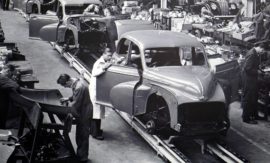Intended learning outcomes: Differentiate between design rules and process rules. Explain the concept of design rules or process rules.
The key to a solution is to extend the business objects by adding a suitable representation of the knowledge about when certain components are built into a variant of a product family and when certain operations become part of the routing sheet. This is accomplished by implementing knowledge-based information systems. For a detailed description of these tools, see Section 17.3.1 and [Schö88b]. For the sake of simplicity, let us explain these systems using our introductory example of the fire damper.
From the perspective of product design, a product family is a single product. For example, there is one single set of drawings for the entire product family. There is one single corresponding bill of material, and it contains all possible components (such as raw materials and semifinished goods) just once; in similar fashion, the single routing sheet contains all possible operations listed just once. By inserting tables or informal remarks, the documents will indicate that certain components or operations will occur only under certain conditions. This characteristic is expressed in design rules or process rules.
A design rule is a position of the bill of material that is conditional as specified by an if-clause, which is a logical expression that varies in the parameters of a product family.
A process rule is a position on the routing sheet that is defined analogously.
Following these definitions, the rules in the fire damper example may be structured like those in Figure 7.3.2.1.
Fig. 7.3.2.1 Design or process rules.
A position of the bill of material or the routing sheet thus becomes a production rule in the actual sense, that is, of a product to be manufactured. These rules are applied to facts, such as the data on item, facilities, and work center in the production database or on parameter values in a query (for example, for a current customer order for a specific product of the product family).
Product designers and process planners in the company function as experts. When they put their rules on paper for variant bills of material and variant routing sheets, they use — unconsciously — expressions that are very similar to production rules. It is evident that these are experts expressing expert knowledge, for no two product designers will deliver precisely the same design for a particular product. In the same way, two process planners will seldom produce exactly the same routing sheet.
The users of the system are those persons who release, control, and produce the orders. The exact realization of production rules in an information system is treated in Section 17.3.2.
Course section 7.3: Subsections and their intended learning outcomes

7.3 Generative Techniques
Intended learning outcomes: Disclose the combinatorial aspect and the problem of redundant data. Present variants in bills of material and routing sheets as production rules of a knowledge-based system. Explain the use of production rules in order processing.

7.3.1 The Combinatorial Aspect and the Problem of Redundant Data
Intended learning outcomes: Present setting the parameters of the fire damper. Disclose the number of possible combinations with n parameters as well as an example for number of identical bill-of-material positions.

7.3.2 Variants in Bills of Material and Routing Sheets: Production Rules of a Knowledge-Based System
Intended learning outcomes: Differentiate between design rules and process rules. Explain the concept of design rules or process rules.

7.3.3 The Use of Production Rules in Order Processing: The Parameterized Bill of Material
Intended learning outcomes: Present an excerpt from the parameterized bill of material for the fire damper.

7.3.3b The Maximum Bill of Material and the Maximum Routing Sheet
Intended learning outcomes: Present the maximum bill of material and maximum routing sheet. Identify data storage complexity for the fire damper example. Disclose the use of generative techniques in connection with CAD and CAM as well as in the service industries.
